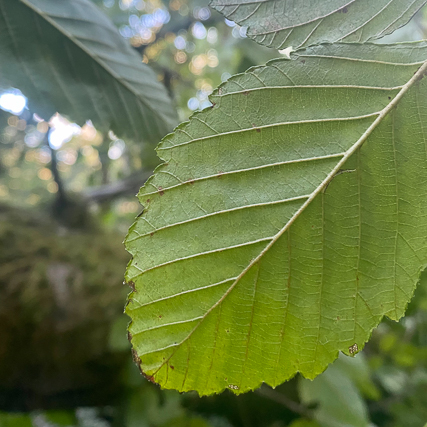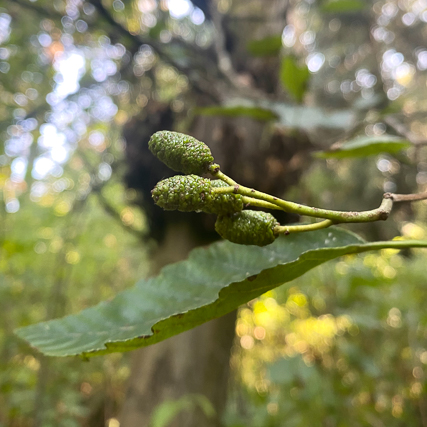fauntleroy tree walk
Red alder
Lushootseed Name:

Latin name:
Alnus rubra
Family:
Betulaceae (birch family) — the family name refers to betulic acid, the antiretroviral, anti- inflammatory, and antimalarial component found within the plants.

Habitat
Red alder is found from southern Alaska all the way to mid-California, with an isolated patch in Idaho.
This species can grow just about anywhere, sometimes colonizing disturbed gravel patches. However, this plant prefers to get its feet wet and tends to grow near bodies of water such as streams, rivers, and lakes.

Identification
growth habit
Red alder exists as fairly thin to medium girth trees under the conifer canopy of Pacific Northwest forests. This species is typically young and will basically grow up to 100 years before dying off. Typically tall from their fast-growing nature, they are able to grow 3 feet within 1 year!
leaves
Eye-shaped with wavy, toothed margin. Lighter colored on the bottom with rolled-under margins.

flower
Contain both female and male “catkins” or reproductive bodies. Male catkins are pendant or tassel-like and yellow to brown with age.
fruits
Contain both female and male catkins. Female catkins are small and cone-like.

bark
Smooth, gray, and speckled with “eyes” where young branches have fallen off in the past.

look-a-likes
Beaked hazelnuts are similar in appearance, yet they have velvety textured leaves rather than corrugated like that of alder. The leaves of beaked hazelnut are indeed beaked, with abrupt tapering ends.
Ecology
Red alder is a bold pioneer of the land, often moving into areas heavily disturbed by logging or landslides and starting the ecosystem build once again. That is actually what happened here, either naturally or planted, as Fauntleroy Park has experienced a past of logging that altered the ecosystem significantly.
So how does red alder do this when other plant species must wait for the right opportunity? First off, red alder fruits are light and wing-shaped cone scales that can easily fly long distances in wind dispersal. Male catkin flowers produce copious amounts of pollen, increasing the odds of successful reproduction.
Most importantly, red alder roots contain nitrogen-fixing bacteria nodules that allow the plant to harness nitrogen from the air and fix it into nutrients within the soil. This provides important nutrients in barren soils for this species and others soon to come. While nitrogen-fixing bacteria is happy feeding on root sugars, red alder is flourishing and prepping the land for conifers to move in and create a shady habitat for other understory species.
Red alder twigs are an important browse and shady habitat for deer and elk. Beavers will use alder wood to build their dama and enjoy the tasty bark. Birds enjoy the seeds and insects associated with the species as well as using the tree for shelter and cavity homes. Insects such as bees relish the abundant pollen.
Red alder provides spectacular shade for streams, creating cool waters for fish. It may also have the ability to neutralize pH of the water, as many acidic soil-loving species like salal and blueberry tend to avoid living in its understory.
Associated plants are typically ferns and grasses. Because this tree contains so much nitrogen, when it dies it can act as a nurse log for other plant species and fungi to sprout from. Take a look at the older red alder trees here; they tend to have a patchwork of white lichen growing along the nutrient-rich bark.
Many of the large trees within this park are nearing the end of their life cycle; they have done their community-building duty and will continue to support other growth in passing.
Ethnobotany
As important as this species is to the ecosystem, it has also played a very important role in medicinal use by humans. This hard wood is used as a lumber source for cabinetry, furniture, boats, and canoe paddles, and it is also used in making paper. It does not contain much resin, making it a great firewood that does not often spark or spit. Native peoples traditionally used alder to smoke salmon.
Ceremonial garb like masks or rattles were typically made from red alder. Red and orange dye can be made from the red inner bark produced with time as you peel away the exterior.
The medicinal properties of this plant are endless. It is in the Betulaceae or birch family, which contains betulic acid — a component that holds antimicrobial, antimalarial, anti-inflammatory properties.
This plant is a cousin of the willow family and it similarly contains salicin, a painkilling and antibiotic component. The bark, female catkins, and new leaves contain high concentrations of these components and are used in medicines to cure infections, mouth sores, colds, cuts and other wounds, diarrhea, and constipation by cleaning out the gut biome of harmful bacteria. It should be used in moderation so as not to wipe out beneficial bacteria.
